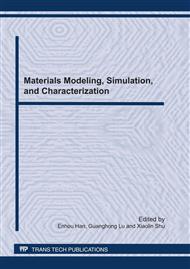p.198
p.204
p.211
p.220
p.226
p.235
p.239
p.245
p.255
The Simulation of Stress-Induced Phase Transition of L10 Re-Precipitation Based on Microscopic Phase-Field Model
Abstract:
It is common that the pre-precipitation phase with kinetics advantage is found during non-equilibrium transformation. The continuously changed stress in the transformation increases the complication of precipitation process. The stress induces Ll0 pre-precipitation phase in Ni75-Al12.5-V12.5 alloy is studied by microscope phase-field model in this paper. It is particularly show that Ll2 phase precipitates directly without stress. There is no Ll0 phase to be found in the disordered matrix. Oppositely, Ll0 phase precipitates firstly with stress, and then it turns into Ll2 phase. When stress is less, either or both above situations are observed. While stress is stronger, a large range of Ll0 phase precipitates firstly. Then a part of it dissolves. The rest turns into Ll2 phase. The precipitation of pre-precipitation phase accelerates the precipitation process. The larger the stress and the more Ll0 phase precipitation, the longer it exists and the shorter the induction period is.
Info:
Periodical:
Pages:
226-234
Citation:
Online since:
June 2011
Authors:
Price:
Сopyright:
© 2011 Trans Tech Publications Ltd. All Rights Reserved
Share:
Citation:


